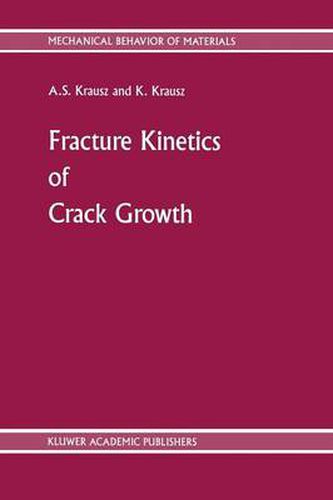Readings Newsletter
Become a Readings Member to make your shopping experience even easier.
Sign in or sign up for free!
You’re not far away from qualifying for FREE standard shipping within Australia
You’ve qualified for FREE standard shipping within Australia
The cart is loading…






This title is printed to order. This book may have been self-published. If so, we cannot guarantee the quality of the content. In the main most books will have gone through the editing process however some may not. We therefore suggest that you be aware of this before ordering this book. If in doubt check either the author or publisher’s details as we are unable to accept any returns unless they are faulty. Please contact us if you have any questions.
Over the past few years, we have made numerous presentations, delivered several series of lectures, and participated in many discussions on the processes of time-dependent crack growth. We felt that the understanding of these processes had reached a degree of maturity: the basic physical principles were established and their application to engineering practice was now feasible. We concluded that the best way to organize this knowledge was to write it up in a single, coherent system. Martinus Nijhoff kindly encouraged us and generously offered their collaboration. Hence, this book. The physical process of time-dependent subcritical crack growth is rigorously defined by statistical mechanics. If well presented, the principles can be readily understood by practitioners of fracture research and design engineers. We present the physical processes of crack growth in terms of atomic interactions that assume only a working knowledge of the standard engineering materials course contents. From this, we develop a framework that is valid for any type of material, be it metallic, polymeric, ceramic, glass or mineral - indeed, any solid. We also assume an elementary exposure to fracture mechanics. An appendix is provided that outlines those aspects of fracture mechanics that are needed for an introduction to fracture kinetics analyses; it also provides a common ground for concepts and terminology (see Appendix A). We proceed through theory to applications that are of interest in research, development and design, as well as in test and operating engineering practice.
$9.00 standard shipping within Australia
FREE standard shipping within Australia for orders over $100.00
Express & International shipping calculated at checkout
This title is printed to order. This book may have been self-published. If so, we cannot guarantee the quality of the content. In the main most books will have gone through the editing process however some may not. We therefore suggest that you be aware of this before ordering this book. If in doubt check either the author or publisher’s details as we are unable to accept any returns unless they are faulty. Please contact us if you have any questions.
Over the past few years, we have made numerous presentations, delivered several series of lectures, and participated in many discussions on the processes of time-dependent crack growth. We felt that the understanding of these processes had reached a degree of maturity: the basic physical principles were established and their application to engineering practice was now feasible. We concluded that the best way to organize this knowledge was to write it up in a single, coherent system. Martinus Nijhoff kindly encouraged us and generously offered their collaboration. Hence, this book. The physical process of time-dependent subcritical crack growth is rigorously defined by statistical mechanics. If well presented, the principles can be readily understood by practitioners of fracture research and design engineers. We present the physical processes of crack growth in terms of atomic interactions that assume only a working knowledge of the standard engineering materials course contents. From this, we develop a framework that is valid for any type of material, be it metallic, polymeric, ceramic, glass or mineral - indeed, any solid. We also assume an elementary exposure to fracture mechanics. An appendix is provided that outlines those aspects of fracture mechanics that are needed for an introduction to fracture kinetics analyses; it also provides a common ground for concepts and terminology (see Appendix A). We proceed through theory to applications that are of interest in research, development and design, as well as in test and operating engineering practice.